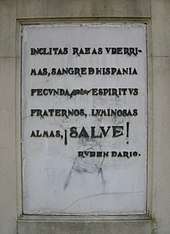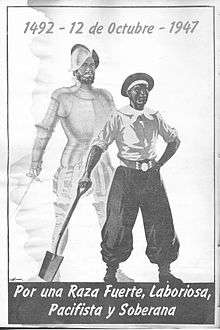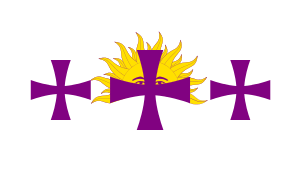La Raza
The Spanish expression la Raza[1] (literally 'the Race') refers to the Hispanophone populations (primarily though not always exclusively in the Western Hemisphere[2]), considered as an ethnic or racial unity historically deriving from the Spanish Empire, and the process of racial miscegenation of the Spanish colonizers with the indigenous populations of the New World (and sometimes Africans brought there by the Atlantic slave trade).
The term was in wide use in Latin America in the early-to-mid 20th century, but has gradually been replaced by Hispanidad in some countries. It remains in active use specifically in the context of Mexican-American identity politics in the United States.
History


The term was, in origin, short for la raza española ('the Spanish race'), introduced by Faustino Rodríguez-San Pedro y Díaz-Argüelles in 1913 with his proposal for a secular Fiesta de la raza española ('Spanish-race Festival') on October 12.
Beginning in the 1920s, the term raza española was criticized, and the alternative term Hispanidad ('Hispanicity') was proposed by Ramiro de Maeztu, based on a suggestion by Zacarías de Vizcarra. Alternatively Mexican writer José Vasconcelos proposed the term la raza cósmica ('the Cosmic Race'), in an essay by the same title, as describing the raza iberoamericana ('Ibero-American race') in 1925. He described this "Cosmic Race" as the end product of gradual racial mixing that was already underway in the former Spanish Empire. Vasconcelos thus replaced the designator española with cosmica in order to imply that racial miscegenation in the former Spanish Empire would lead to the emergence of a completely new "Ibero-American" race.
The shortened name of Día de la Raza (now often, though not always, with a capitalized R) was used in 1939, when the feast day was celebrated in Zaragoza in combination with a special devotion to the Virgen del Pilar (Our Lady of the Pillar). Chilean foreign vice-secretary Germán Vergara Donoso commented that the "profound significance of the celebration was the intimate inter-penetration of the homage to the Race and the devotion to Our Lady of the Pillar, i.e. the symbol of the ever more extensive union between America and Spain."[3]
Francisco Franco wrote a novel under the pen name "Jaime de Andrade" which was turned into the film Raza of 1944. It celebrates idealized "Spanish national qualities", and exemplifies this usage of raza española as referring specifically to Spanish Roman Catholic heritage. In Central America and Mexico, la Raza emphasizes an Amerindian or mestizo heritage, or it may express Latino identity (la Raza being taken as short for la raza iberoamericana, following Vasconcelos). A Monumento a la Raza ('Monument to the Race') was inaugurated in Mexico City in 1940. La Raza station station in Mexico City was inaugurated in 1978.
The term Chicano (feminine Chicana, sometimes rendered Chicano/a, Chican@ or Chicanx by proponents of gender-neutral language) likewise arose in the early 20th century as a designation of Mexicans. In the 1960s to 1970s, the term became associated with a movement of Mexican-American identity politics activism. In the United States, the terms la Raza and Chicano subsequently became closely associated.[4] Various Hispanic groups in the United States still use the term.[5] The Raza Unida Party was active as a political party representing Mexican-American racial identity politics in the 1970s. The Hispanic advocacy organization National Council of La Raza was formed in 1968 (renamed to UnidosUS in 2017).
La Raza was the name of a Chicano community newspaper edited by Eliezer Risco in 1968. Risco was one of the "LA Thirteen", a group of young Mexican-American men who were political activists identified by the government as being leaders of a Brown Power movement in Los Angeles. Raul Ruiz joined the staff of La Raza while a student at California State University Los Angeles. Other community newspapers of the time were Inside Eastside and Chicano Student Movement. Ruiz, a key journalist in the movement, eventually became the editor of La Raza.[6] It became the most influential Chicano-movement publication in Southern California. The publications filled a void: for the most part, there had heretofore been no media coverage of any type for the Brown Power movement and its activities. The movement's own print-media publications were really the only forum that the Brown Power movement had to keep party members informed about what was going on in the movement across the Los Angeles area. The lack of the mainstream media coverage contributed to silencing the movement and its activities, unlike with the Black Power movement; the latter received much more coverage, which contributed to that movement's success in spreading their message and growing their movement (despite not all of the coverage being positive).[7]
See also
References
- ↑ Sometimes over-capitalized as La Raza, or given in all-lowercase as la raza.
- ↑ Filipinos and people in formerly Spanish-colonial Africa are sometimes included in modern conceptions of the term.
- ↑ Bueno Sánchez, Gustavo. "Día de la Hispanidad". Filosofia.org (in Spanish).
- ↑ Alaniz, Yolanda; Cornish, Megan (2008). Viva La Raza: A History of Chicano Identity and Resistance. Seattle: Red Letter Press. p. 181.
- ↑ Romero, Dennis (June 7, 2016). "Dear Trump Fans: La Raza Is Not a Racist Term". Los Angeles Weekly. Retrieved June 7, 2016.
- ↑ García, Mario T. (2015). The Chicano Generation: Testimonios of the Movement. Berkeley, California: University of California Press. ISBN 9780520286023. OCLC 904133300.
- ↑ Muñoz, Carlos (2007). Youth, Identity, Power: The Chicano Movement (rev. and expanded ed.). London: Verso. ISBN 9781844671427. OCLC 124026434.
